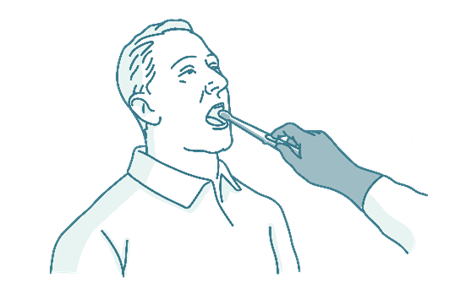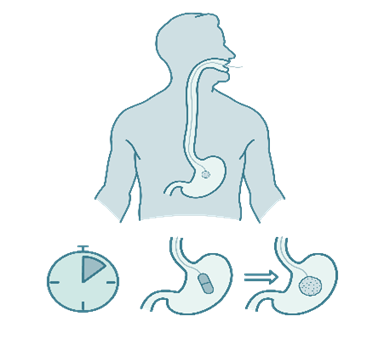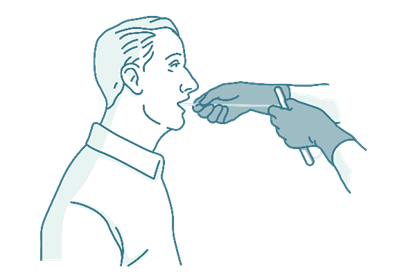Capsule Sponge Test
This page provides you with information about having a capsule sponge test.
This page explains:
- What the test is and why you might need it.
- The benefits of the test.
- How you prepare for a test.
- How the test is carried out.
- What happens after the test.
- What the risks of the test might be.
- How you will receive your results.
What is a capsule sponge test?
A capsule sponge test is designed to collect cells from the lining of your oesophagus (food pipe), which can then be tested to check for any abnormalities. It requires you to swallow a capsule on a string which is approximately the size of a vitamin tablet and is made of vegan gelatin. The string is then used to pull the capsule out of the stomach via your mouth.
Why have I been offered a capsule sponge test?
You have been offered a capsule sponge test to investigate your symptoms of acid reflux or heartburn. Problems with heartburn and acid reflux are very common but occasionally this can lead to a condition called Barrett’s oesophagus.
Barrett’s oesophagus is not cancer, but over time cell changes may mean they start to grow more abnormally. This is called dysplasia. In less than 1% of patients with Barrett’s oesophagus dysplasia will develop into cancer.
You are being offered a capsule sponge to test for Barrett’s oesophagus because when changes to cells are found early, it can make any treatment much simpler, and the impact on a patient is much less significant. Patients with a known diagnosis of Barrett’s oesophagus may also be eligible for this test for surveillance purposes.
What are the benefits of having the test?
A capsule sponge test is a safe and effective investigation for patients who meet specific criteria and can help to provide a diagnosis without having an upper endoscopy (inserting a long, flexible tube called an endoscope down the throat and into the oesophagus).
A capsule sponge test is a less invasive test than having an endoscopy and is also much quicker. It takes less than 10 minutes to carry out.
As you will not require any sedation or spray to numb your throat, you can eat and drink as normal once your test is complete, and will be able to drive and return to home or work straight after your procedure.
Preparation for the test
- You should not have anything to eat or drink for 4 hours before your appointment.
- You should take your regular medications on the day of your procedure, but with as little water as possible.
- If you take medication for diabetes, you will be asked to have an early light breakfast at 6 am and to take your diabetic medication as normal. You will then be given a late morning appointment.
If you take any blood-thinning medication, please follow this advice:
Warfarin
- You will need to have an INR test (International Normalised Ratio) the week before your capsule sponge test.
- Your INR must be 3.5 or less when you have the capsule sponge test.
- If your INR is within your target range, then continue with your usual dose.
- If your INR is not within your target range, please contact your anticoagulant clinic for advice, as your dose may need to be adjusted.
- If your INR result is above 3.5, contact your anticoagulant clinic or GP for advice.
Anti-platelet medication
- Continue your normal dose of Clopidogrel, Aspirin, Prasugrel, Ticagrelor or any other anti-platelet medication.
Other anticoagulants
- If you take Rivaroxaban, Apixaban, Edoxaban or Dabigatran, you should not take this medication on the day of your test. You should restart your medication the day after your capsule sponge test. Continue with your usual dose.
- If you have any questions about your blood-thinning medication please contact the capsule sponge team on the number provided on this page.
On the day of the test
- You will be given a 30-minute outpatient appointment, but the test itself only takes about 10 minutes to carry out.
- At your appointment, a nurse will go through the test with you and answer any questions you may have.
- The nurse will ask you to sign a consent form agreeing to the test.
The nurse uses an applicator to place the capsule on the back of your tongue. You will be given some warm water to drink and asked to swallow the capsule.
After swallowing, the capsule will remain in your stomach for 7 minutes until it dissolves, releasing the sponge into your stomach.
The nurse will gently remove the sponge by pulling the string. This will only take 1 to 2 seconds and should not be painful. As the sponge is pulled out, it collects cells from the lining of your oesophagus. It may feel as though the inside of your oesophagus is being brushed.



After your test
- Straight after the test you can carry on with your day as normal. You can drive, go home or go back to work.
- You can eat and drink normally straight away.
- The cell samples obtained from your test will be sent to the laboratory to be tested.
Potential risks and side-effects
The capsule sponge test has been extensively tested in clinical trials and has been shown to be very safe and accurate, with no serious side effects.
Swallowing the capsule is not painful, and most people have no problem doing so.
In the unlikely event that you do have a problem in swallowing the capsule, we will not continue with the test, and you will be added to the waiting list for an upper endoscopy.
You may experience a mild sore throat after the test. Paracetamol and throat lozenges can help to soothe this.
If your heartburn symptoms become worse, you should take your heartburn medication as prescribed.
It is very unlikely that you will experience any other symptoms, however if you experience severe pain or bleeding, contact the capsule sponge team Monday to Friday, 9:00 am to 5:00 pm. Outside of these hours you should call NHS 111 telling them that you have had a capsule sponge test.
There is an extremely small risk (less than 1 in 2000) that the capsule may become detached from the string, or it may be difficult to remove the sponge. If this happens, it is not dangerous, but we will arrange for you to have a same-day upper endoscopy to remove the sponge at Gloucestershire Royal Hospital.
Like all tests, capsule sponge may not always find all abnormalities. On very rare occasions, a serious abnormality might not be identified. If you have any questions about this, please contact the capsule sponge team.
Results
The results of your test should be available within 4 weeks of you having your procedure.
If the test shows that your cells are normal, you will receive your results by letter.
If the test finds any abnormalities or is inconclusive, a member of the capsule sponge team will call you to discuss what action may be needed. This may include a repeat capsule sponge test or an upper endoscopy.
Contact details
If you have any questions about this page or would like further information about the capsule sponge test, please contact: the
Capsule Sponge Team
Tel: 0300 422 8237 / 8224
Monday to Friday, 9:00am to 5:00pm
E-mail: ghn-tr.capsulesponge@nhs.net